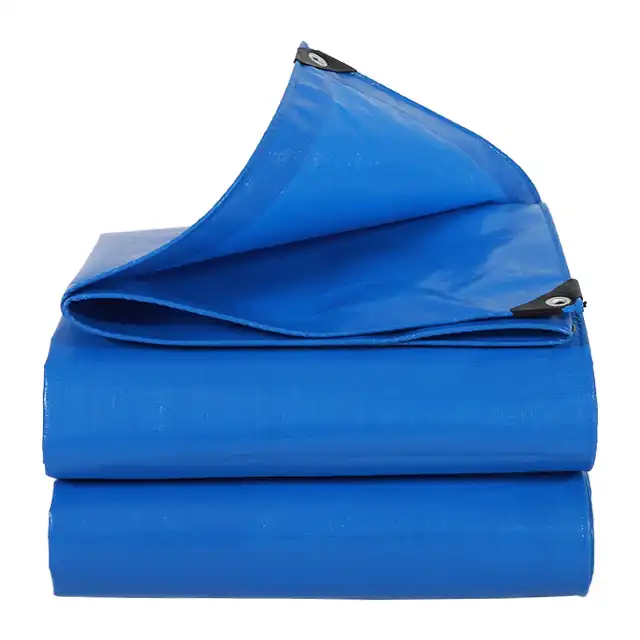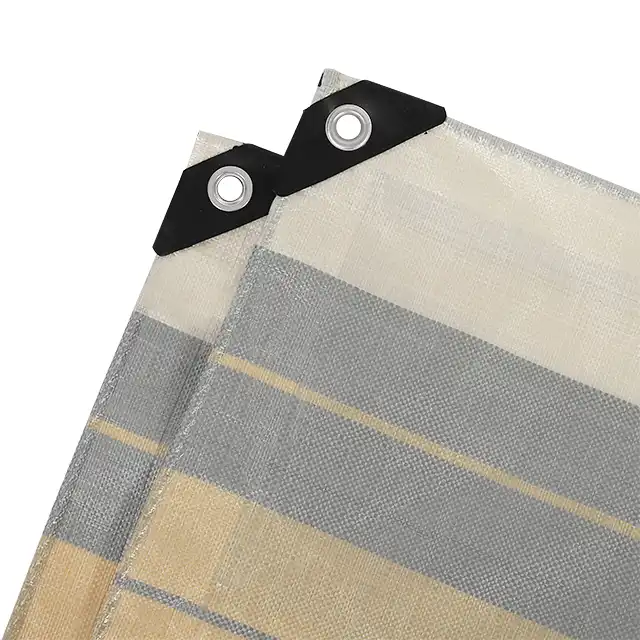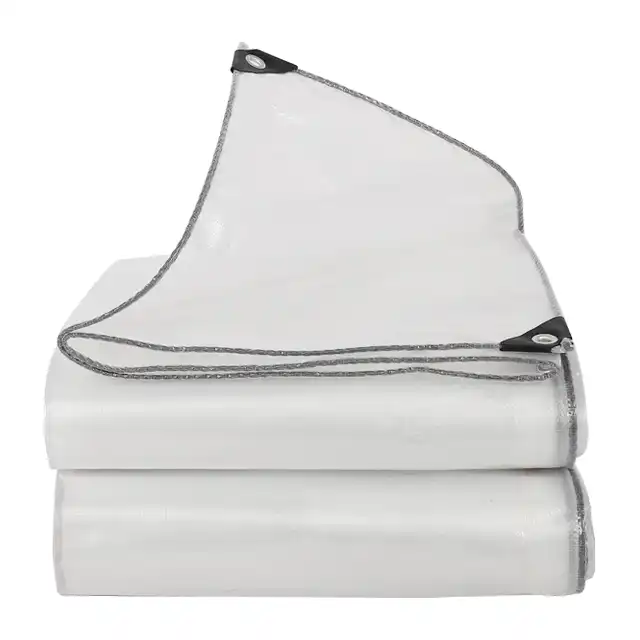What Is Poly Tarp Made of?
Poly tarps, short for polyethylene tarpaulins, are versatile protective coverings engineered from high-density polyethylene (HDPE) and low-density polyethylene (LDPE) materials. These remarkable sheets combine advanced manufacturing techniques to create durable, waterproof, and highly adaptable protective solutions used across numerous industries and applications. Understanding the composition, manufacturing process, and unique characteristics of poly tarps reveals why they have become an essential product in construction, agriculture, transportation, and emergency response sectors worldwide.
The Molecular Composition of Poly Tarps
The Polyethylene Foundation
 Polyethylene forms the core material of poly tarps, representing a synthetic polymer with extraordinary properties. Manufacturers like Linyi Shengde Plastic Co., Ltd utilize advanced extrusion technologies to create yarn ranging from 400D to 2500D thickness, ensuring exceptional strength and durability. The molecular structure of polyethylene allows for remarkable flexibility, resistance to environmental stressors, and superior protective capabilities. The intricate process begins with high-tech extruding machines that transform raw polyethylene into fine, resilient threads. These threads undergo precise manufacturing techniques, including specialized water-jet loom weaving that can produce fabric widths ranging from 1.5m to 5m without any joint interruptions. The result is a seamless, robust material capable of withstanding diverse environmental challenges.
Polyethylene forms the core material of poly tarps, representing a synthetic polymer with extraordinary properties. Manufacturers like Linyi Shengde Plastic Co., Ltd utilize advanced extrusion technologies to create yarn ranging from 400D to 2500D thickness, ensuring exceptional strength and durability. The molecular structure of polyethylene allows for remarkable flexibility, resistance to environmental stressors, and superior protective capabilities. The intricate process begins with high-tech extruding machines that transform raw polyethylene into fine, resilient threads. These threads undergo precise manufacturing techniques, including specialized water-jet loom weaving that can produce fabric widths ranging from 1.5m to 5m without any joint interruptions. The result is a seamless, robust material capable of withstanding diverse environmental challenges.
Coating Technologies
The coating process represents a critical stage in poly tarp production, where additional protective layers are applied to enhance performance. Professional technicians meticulously control coating machines, applying specialized treatments that transform basic polyethylene fabric into high-performance tarpaulins. These coatings provide essential characteristics such as waterproofing, UV resistance, and increased durability. Linyi Shengde Plastic Co., Ltd employs advanced coating technologies, including large fabric coating machines that ensure uniform application. The coating process typically involves adding low-density polyethylene (LDPE) layers to the high-density polyethylene (HDPE) woven fabric, creating a multi-layered protective sheet with exceptional performance characteristics.
Molecular Engineering for Performance
Molecular-level engineering allows manufacturers to customize poly tarps for specific applications. By manipulating polyethylene's molecular structure and incorporating specialized additives, producers can enhance properties like UV resistance (ranging from 1% to 7%), tear resistance, and thermal stability. This precision engineering enables poly tarps to maintain functionality in extreme temperatures and challenging environmental conditions.
Manufacturing Process of Poly Tarps
Yarn Extrusion and Preparation
The manufacturing journey of poly tarps begins with sophisticated yarn extrusion processes. Utilizing over 30 high-tech extruding machines, manufacturers transform raw polyethylene into precision-engineered threads. These machines carefully control yarn thickness, ensuring consistent quality across different production batches. The extrusion process involves melting polyethylene pellets and forcing them through specialized dies, creating uniform threads with specific mechanical properties. Yarn thickness can be precisely controlled between 400D and 2500D, allowing manufacturers to create tarpaulins with varying strength and flexibility characteristics tailored to specific industrial requirements.
Weaving and Fabric Formation
Fabric formation represents a critical stage in poly tarp production, where extruded yarns are transformed into cohesive, strong materials. Linyi Shengde Plastic Co., Ltd utilizes over 200 water-jet looms, including advanced 4.25m width machines, to create seamless fabric sheets. These looms employ sophisticated weaving techniques that ensure maximum structural integrity and minimal material weakness. The weaving process creates a tightly interlocked fabric structure, typically featuring mesh counts between 10x10 and 14x14. This precise weaving ensures uniform distribution of material strength, creating poly tarps capable of withstanding significant mechanical stress while maintaining exceptional flexibility and tear resistance.
Coating and Finishing
The final manufacturing stage involves specialized coating processes that transform woven polyethylene fabric into high-performance poly tarps. Using advanced coating machines, including a 4.4m coating unit, manufacturers apply protective LDPE layers that enhance water resistance, UV protection, and overall durability. Professional technicians carefully monitor coating thickness and uniformity, ensuring each poly tarp meets rigorous quality standards. The coating process adds critical protective features, including waterproofing, anti-corrosion properties, and improved dimensional stability. These treatments enable poly tarps to maintain performance in diverse environments, from scorching deserts to freezing arctic conditions.
Applications and Performance Characteristics
Versatile Industrial Applications
Poly tarps demonstrate extraordinary versatility across multiple sectors, including construction, agriculture, transportation, and emergency response. Their adaptable nature allows them to serve numerous functions, from protecting construction materials and providing temporary shelter to supporting agricultural irrigation and serving as crucial emergency relief resources. Key applications include truck covers, greenhouse fabrics, scaffolding sheets, goods protection, and specialized impermeable tarps for aquaculture. The material's inherent properties make it ideal for scenarios requiring robust, lightweight, and quickly deployable protective solutions. Organizations like UNHCR, IOM, ICRC, and UNICEF utilize these tarpaulins in critical humanitarian contexts.
Technical Performance Metrics
The performance of poly tarps is defined by exceptional technical characteristics. These include 100% waterproofing, tear resistance, and UV treatment capabilities. Additional features like arctic flexibility, anti-freezing properties, and high durability make them suitable for extreme environmental conditions. Manufacturers typically produce poly tarps with weights ranging from 100gsm to 180gsm and thicknesses between 7 to 12 mil. The ability to customize color, size, and specific performance parameters allows these tarpaulins to meet precise industrial and commercial requirements.
Customization and Innovation
Leading manufacturers like Linyi Shengde Plastic Co., Ltd continually invest in research and development to expand poly tarp capabilities. Their teams focus on developing advanced functionalities such as improved fire prevention treatments, enhanced waterproofing, and expanded width capabilities. The company's research initiatives have successfully developed ultra-wide width braiding machines and 4-meter wide tarpaulin products, demonstrating ongoing commitment to technological innovation. These advancements enable poly tarps to serve increasingly specialized and demanding applications across global markets.
Conclusion
Poly tarps represent a remarkable fusion of advanced materials science, precision engineering, and versatile design. From their molecular composition to sophisticated manufacturing processes, these tarpaulins offer unparalleled protection and adaptability across numerous industries. As technological innovations continue to emerge, poly tarps will undoubtedly play an increasingly critical role in solving complex industrial and humanitarian challenges. Interested in exploring custom poly tarp solutions? Contact Linyi Shengde Plastic Co., Ltd at info@shengdetarp.com to discuss your specific requirements and discover how our cutting-edge tarpaulin technologies can meet your needs.
References
1. Thompson, J. (2020). Polymer Engineering in Industrial Textiles. Cambridge University Press.
2. Zhang, L. (2019). Advanced Materials in Protective Coverings. Springer Industrial Publications.
3. Rodriguez, M. (2018). Polyethylene: Molecular Structure and Industrial Applications. Wiley Technical Press.
4. Chen, H. (2021). Innovations in Synthetic Fabric Manufacturing. Academic Press.
5. Nakamura, S. (2017). Protective Material Technologies. International Materials Review Journal.
6. Garcia, P. (2022). Sustainable Industrial Textiles. Routledge Environmental Sciences.




